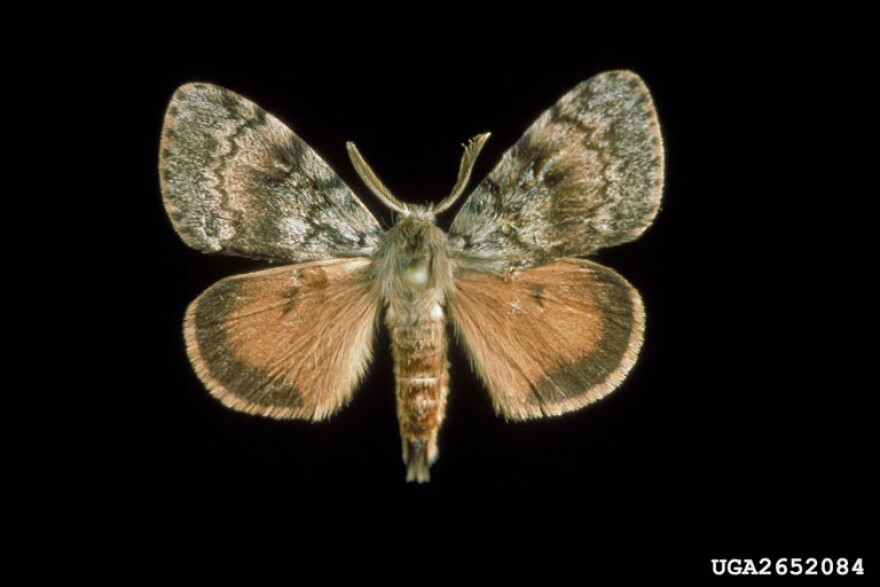Andrew Conkling lives in Kalamazoo, in a house with a big oak tree in the middle of the backyard. He and his four kids like to observe the insect life out there.
“We have ground bees this year, and we’ve had wasps before that we had to get rid of. The ground bees apparently are gentle so we don’t have to do anything about those. We don’t really like to kill stuff,” he added.
But he’s wondering what he should do about gypsy moths. Or more specifically, the fuzzy, spotted gypsy moth caterpillars he finds on his oak tree in the summer.
Gypsy moths are non-native. They’re considered invasive. The caterpillars feast on oak and many other hardwood leaves, and can defoliate whole trees. By leaving them alone, Andrew wonders if he’s endangering his backyard oak and even the local biome.
“Do I leave them alone, try to get rid of them, somewhere in between? Is there an in between?” he asks.
Reassuringly, there probably is, says Michigan State University entomologist Deb McCullough. She’s studied gypsy moths for years, and says, though the voracious caterpillars can be a nuisance, there’s no need to panic over them.
But plenty of people have.
“I actually think the story of gypsy moth in North America is fascinating. It’s one of the few invasive forest insects, invasive pests in general that didn’t come into the country accidentally. It was actually brought in intentionally,” McCullough said.
Gypsy moths were brought to the U.S. by French political exile and amateur naturalist (and later, noted artist) Etienne Trouvelot, who in the 1860s was living in Medford, Massachusetts, near Boston. The silk industry was booming, and Trouvelot thought gypsy moths might make good silkworms. McCullough says the species has a wide range across Africa, Asia and Europe.
“That’s part of the reason why it can feed on so many different kinds of trees, as well as woody shrubs,” she explained.
The female moths are white with brown markings. The males, which are smaller, are patterned light-and-dark brown. The caterpillars hatch around now in Southwest Michigan. When they’re young, they’re black and fuzzy. As they mature they develop distinctive blue and red dots down their backs.

“The head is kind of yellow with some black mottling and they have long hairs coming out from them,” McCullough added.
Trouvelot imported some of the insects and started raising them at his home in Medford. From where, as you might have guessed, they soon escaped. Being adapted to a range of habitats, they had no trouble finding leaves to eat. A couple decades later, the population exploded.
“It turns into, just making everybody crazy in Massachusetts and it’s even spreading now into adjacent states,” McCullough said.
Alarmed residents tried to wipe out the moths. They hired men to climb trees and scrape off the egg masses. They also used a new insecticide, lead arsenate – a dubious salt made with, yes, lead and arsenic – which causes lasting pollution. Despite these efforts, the moths kept spreading. McCullough says they took about 100 more years to reach Michigan.

There were “Lots of efforts to suppress the populations, contain them but by the early 1990s the whole state was considered to be generally infested,” she said.
Thirty years later they’re still here, munching away on the leaves of trees from oaks to willows to crabapples. McCullough said gypsy moths likely defoliated about a million acres of Michigan forest in 2020. But she added that gypsy moths in the US now have two big pests of their own.
One is a fungus, the other’s a virus. She said now, when gypsy moths get established somewhere they tend to have a couple good years. But then,
“The caterpillars start to die from the virus, or the fungus or both, and by that fourth year or so, the population should be on its way out. And then it should stay low for some matter of time, some number of years before it blows back up again,” she said.
And McCullough added, though it’s not ideal, healthy, otherwise-thriving hardwood trees can generally survive having their leaves eaten off. Even a few years in a row.
But McCullough’s sympathetic to homeowners distressed about a gypsy moth outbreak. She said living through one can be an ordeal. The caterpillars rain droppings out of the sky, and those can be slippery. The caterpillars get into people’s houses and sometimes into their beds. At night they come down from the trees looking for a place to sleep.

“You get this swarming of these big hairy caterpillars and that can make people a little crazy too,” she said.
Scraping egg masses into soapy water will help to protect a tree. (Don’t use an acetylene torch to burn them off, as one Kalamazoo-area homeowner apparently did, killing the tree he was trying to protect). Tying burlap around the trunk and collecting the descending caterpillars is another way to cut their numbers. There’s also a strain of Bt, a bacterial insecticide, that kills them. The MSU Extension has more information on gypsy moth management here.
Harsher treatments can be used. But McCullough said, if you don’t mind the caterpillars, there’s no need to get rid of them.
“The dynamics of the population in a given area is not going to be affected by what homeowners do, by and large,” she said.
Conkling said he’s happy to meet the caterpillars in the middle.

“Maybe I’ll clear some out if they look really big, maybe I’ll leave them alone and we can enjoy them as just a bit of scientific observation,” he said.





